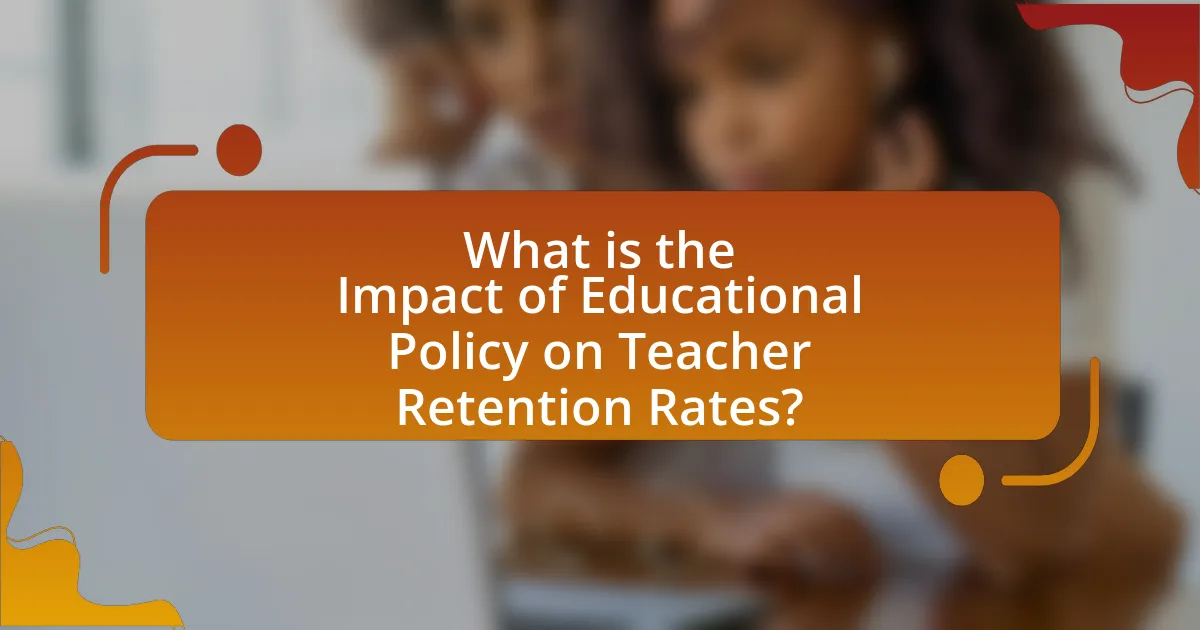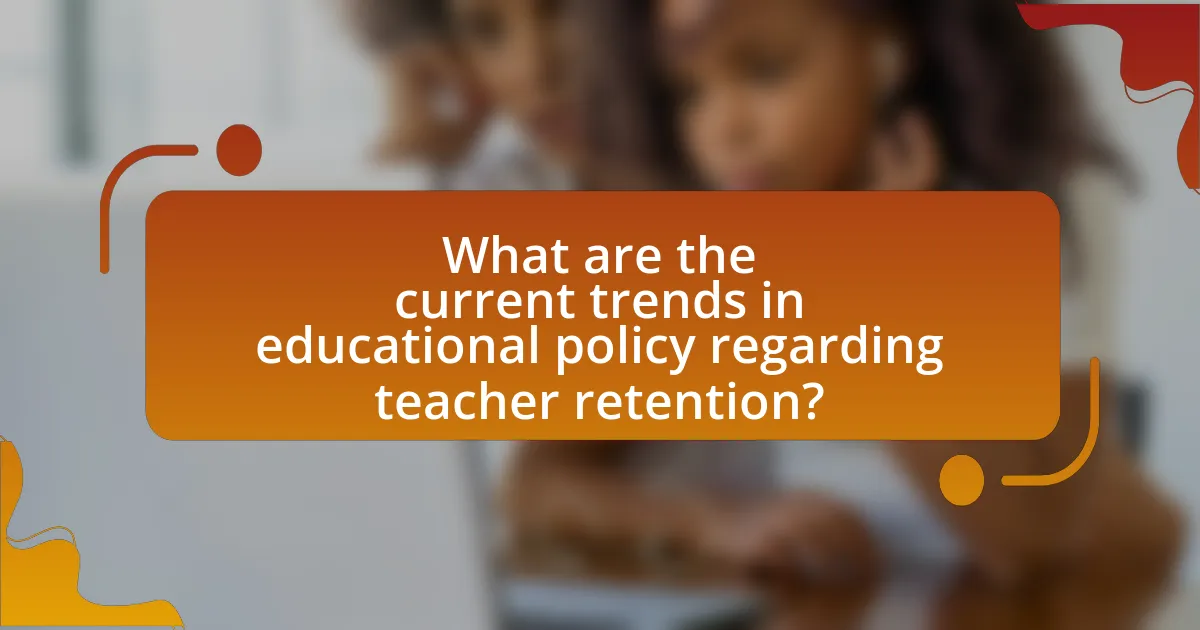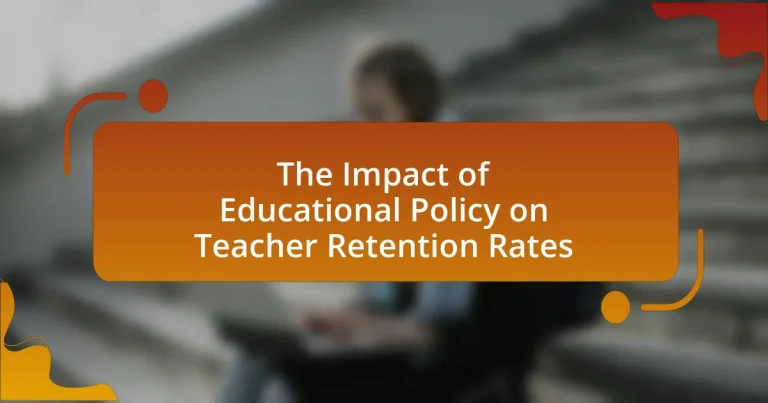The article examines the impact of educational policy on teacher retention rates, highlighting how policies related to salary, professional development, and working conditions influence teachers’ decisions to remain in the profession. It discusses specific effective policies, such as competitive salaries and comprehensive support systems, and their correlation with job satisfaction and retention. Additionally, the article addresses the consequences of high turnover rates on student outcomes and school stability, while exploring current trends and challenges in educational policy aimed at improving teacher retention. The role of administrative support and collaboration among stakeholders in creating effective retention strategies is also emphasized.

What is the Impact of Educational Policy on Teacher Retention Rates?
Educational policy significantly influences teacher retention rates by establishing frameworks that affect job satisfaction, professional development, and working conditions. Policies that prioritize competitive salaries, adequate support, and ongoing training have been shown to reduce turnover; for instance, a study by Ingersoll (2001) found that schools with strong induction programs for new teachers experienced lower attrition rates. Additionally, policies that foster collaborative environments and provide resources for classroom management contribute to higher retention, as evidenced by research from the National Center for Education Statistics, which indicates that teachers who feel supported are more likely to remain in their positions.
How do educational policies influence teacher retention?
Educational policies significantly influence teacher retention by establishing frameworks that affect job satisfaction, professional development, and compensation. For instance, policies that promote competitive salaries and benefits have been shown to reduce turnover rates; a study by Ingersoll (2001) found that higher salaries correlate with lower attrition among teachers. Additionally, policies that support ongoing professional development and mentorship programs enhance teachers’ skills and job satisfaction, leading to increased retention. Research from the National Center for Education Statistics indicates that teachers who feel supported by their administration and have access to professional growth opportunities are more likely to remain in their positions. Thus, effective educational policies directly impact teacher retention by addressing key factors that contribute to teachers’ decisions to stay in or leave the profession.
What specific policies are most effective in retaining teachers?
Specific policies that are most effective in retaining teachers include competitive salaries, comprehensive professional development programs, and supportive working conditions. Research indicates that competitive salaries directly correlate with teacher satisfaction and retention; for instance, a study by the National Center for Education Statistics found that higher salaries can reduce turnover rates significantly. Comprehensive professional development programs enhance teachers’ skills and job satisfaction, as evidenced by a report from the Learning Policy Institute, which states that ongoing training leads to improved teacher retention. Additionally, supportive working conditions, such as manageable class sizes and administrative support, have been shown to create a positive work environment, further contributing to teacher retention, as highlighted in a study by the American Educational Research Association.
How do changes in educational policy affect teacher job satisfaction?
Changes in educational policy significantly affect teacher job satisfaction by altering working conditions, expectations, and support systems. For instance, policies that increase funding for professional development and resources tend to enhance job satisfaction, as teachers feel more equipped and valued in their roles. Conversely, policies that impose high-stakes testing and accountability measures can lead to increased stress and dissatisfaction among educators, as evidenced by a study published in the “Journal of Educational Psychology,” which found that teachers in high-pressure environments reported lower job satisfaction levels. Thus, the nature of educational policy directly influences how teachers perceive their work environment and overall job fulfillment.
Why is teacher retention important in the educational system?
Teacher retention is crucial in the educational system because it directly affects student achievement and school stability. High turnover rates disrupt the learning environment, leading to inconsistent teaching quality and negatively impacting student performance. Research indicates that schools with higher teacher retention rates often see improved student outcomes, as experienced teachers contribute to better classroom management and instructional effectiveness. For instance, a study by Ingersoll (2001) found that schools with stable teaching staff had higher student test scores compared to those with high turnover. Thus, retaining teachers is essential for fostering a conducive learning atmosphere and enhancing educational quality.
What are the consequences of high teacher turnover rates?
High teacher turnover rates lead to significant negative consequences for educational institutions, students, and the overall learning environment. These consequences include decreased student achievement, as studies show that schools with high turnover often struggle to maintain consistent teaching quality, which directly impacts student performance. Additionally, high turnover disrupts school culture and community, resulting in a lack of continuity in teaching methods and relationships, which are crucial for effective learning. Research indicates that schools with high turnover rates experience increased costs related to recruitment and training of new teachers, which can strain budgets and resources. Furthermore, high turnover can contribute to teacher burnout and dissatisfaction, perpetuating a cycle of instability within the educational system.
How does teacher retention impact student outcomes?
Teacher retention significantly enhances student outcomes by providing stability and continuity in the learning environment. When teachers remain in their positions, they develop stronger relationships with students, which fosters trust and engagement. Research indicates that consistent teaching staff leads to improved academic performance; for instance, a study by the National Bureau of Economic Research found that students taught by the same teacher for multiple years score higher on standardized tests compared to those with frequently changing teachers. Additionally, retained teachers are more likely to implement effective teaching strategies and understand their students’ individual needs, further contributing to better educational results.

What factors within educational policy affect teacher retention rates?
Educational policies significantly influence teacher retention rates through factors such as salary structures, professional development opportunities, and working conditions. Research indicates that competitive salaries are crucial; for instance, a study by Ingersoll (2001) found that higher pay correlates with lower turnover rates among teachers. Additionally, policies that promote ongoing professional development enhance job satisfaction and commitment, as evidenced by a report from the National Center for Education Statistics, which shows that teachers who engage in regular training are more likely to remain in their positions. Furthermore, supportive working conditions, including manageable class sizes and administrative support, are linked to higher retention rates, as highlighted in a study by the Learning Policy Institute, which found that teachers in positive environments are less likely to leave the profession.
How do funding and resource allocation influence teacher retention?
Funding and resource allocation significantly influence teacher retention by directly affecting job satisfaction and working conditions. Adequate funding allows schools to provide competitive salaries, benefits, and professional development opportunities, which are crucial for retaining qualified teachers. Research indicates that schools with higher funding levels report lower turnover rates, as teachers feel more supported and valued in their roles. For instance, a study by Ingersoll (2001) found that schools with better resources and support systems had a 50% lower turnover rate compared to those with inadequate funding. This correlation highlights the importance of financial investment in educational resources to enhance teacher retention.
What role does salary play in teacher retention rates?
Salary significantly influences teacher retention rates, as higher salaries are associated with increased job satisfaction and reduced turnover. Research indicates that teachers who receive competitive compensation are more likely to remain in their positions, with studies showing that a 10% increase in salary can lead to a 5% decrease in attrition rates. Additionally, a report by the National Center for Education Statistics highlights that financial incentives play a crucial role in attracting and retaining qualified educators, particularly in high-need areas.
How do professional development opportunities affect teacher decisions to stay?
Professional development opportunities significantly enhance teacher decisions to stay in their positions. Research indicates that when teachers engage in meaningful professional development, they feel more competent and supported, which directly correlates with their job satisfaction and commitment to their schools. For instance, a study by the National Center for Education Statistics found that teachers who participated in high-quality professional development were 50% more likely to remain in their schools compared to those who did not. This suggests that effective professional development not only improves teaching practices but also fosters a sense of belonging and professional growth, ultimately influencing teachers’ decisions to continue their careers in education.
What role does administrative support play in teacher retention?
Administrative support significantly enhances teacher retention by providing essential resources, guidance, and a positive work environment. Effective administrative support includes mentorship programs, professional development opportunities, and recognition of teachers’ efforts, which contribute to job satisfaction and a sense of belonging. Research indicates that schools with strong administrative backing experience lower turnover rates; for instance, a study by Ingersoll (2001) found that supportive leadership is a key factor in retaining teachers, as it fosters a collaborative culture and addresses teachers’ needs. This correlation underscores the critical role that administrative support plays in maintaining a stable teaching workforce.
How can school leadership impact teacher morale and retention?
School leadership significantly impacts teacher morale and retention by fostering a supportive and collaborative environment. Effective leaders promote open communication, provide professional development opportunities, and recognize teacher achievements, which enhances job satisfaction. Research indicates that schools with strong leadership have lower turnover rates; for instance, a study by the Wallace Foundation found that effective school leadership is linked to improved teacher retention and student outcomes. This correlation underscores the importance of leadership in creating a positive school culture that values and supports educators.
What strategies can administrators implement to support teachers?
Administrators can implement several strategies to support teachers, including providing professional development opportunities, fostering a collaborative work environment, and offering mental health resources. Professional development programs enhance teachers’ skills and knowledge, which can lead to increased job satisfaction and retention. Research indicates that schools with strong professional development frameworks see a 10% increase in teacher retention rates. Collaborative environments, where teachers share resources and strategies, promote a sense of community and belonging, further contributing to retention. Additionally, access to mental health resources helps teachers manage stress and burnout, which are significant factors in teacher turnover. Studies show that schools prioritizing mental health support experience lower attrition rates among educators.

What are the current trends in educational policy regarding teacher retention?
Current trends in educational policy regarding teacher retention focus on enhancing support systems, improving working conditions, and increasing compensation. Policies are increasingly emphasizing mentorship programs, professional development opportunities, and mental health resources to create a more supportive environment for teachers. For instance, a report from the National Center for Education Statistics indicates that schools implementing comprehensive induction programs for new teachers see a retention rate increase of up to 50%. Additionally, many states are raising teacher salaries to address the financial challenges that contribute to turnover, with some states reporting salary increases of 10% or more in recent years. These trends reflect a growing recognition of the importance of teacher well-being and job satisfaction in retaining qualified educators.
How are recent educational reforms addressing teacher retention issues?
Recent educational reforms are addressing teacher retention issues by implementing measures that enhance job satisfaction and professional development opportunities. These reforms include increased funding for teacher salaries, which has been shown to improve retention rates; for instance, a study by the National Bureau of Economic Research found that a 10% increase in teacher salaries can reduce turnover by 5%. Additionally, reforms are focusing on mentorship programs and ongoing training, which provide new teachers with support and resources, leading to a more sustainable teaching workforce. Evidence from the Learning Policy Institute indicates that comprehensive induction programs can increase retention rates by up to 50% in the first few years of teaching.
What innovative policies have been implemented to improve retention rates?
Innovative policies implemented to improve retention rates include mentorship programs, competitive salary structures, and enhanced professional development opportunities. Mentorship programs pair new teachers with experienced educators, fostering support and guidance, which has been shown to reduce turnover by up to 50% in some districts. Competitive salary structures attract and retain quality educators, with studies indicating that a 10% salary increase can lead to a 5% decrease in attrition rates. Enhanced professional development opportunities, such as ongoing training and leadership pathways, empower teachers and increase job satisfaction, contributing to higher retention rates.
How do state and federal policies differ in their approach to teacher retention?
State and federal policies differ significantly in their approach to teacher retention, with states often implementing localized strategies while federal policies provide overarching frameworks. State policies typically focus on specific incentives such as salary increases, mentorship programs, and professional development tailored to local needs, which can lead to higher retention rates; for example, states like Texas have introduced programs that offer bonuses for teachers in high-need areas. In contrast, federal policies, such as the Every Student Succeeds Act (ESSA), emphasize accountability and equitable access to quality education but do not directly mandate specific retention strategies, leaving the execution to individual states. This distinction highlights how state-level initiatives can be more responsive to local challenges, while federal policies set broader educational goals without detailed retention mechanisms.
What challenges do educational policies face in improving teacher retention?
Educational policies face significant challenges in improving teacher retention, primarily due to inadequate funding, lack of support systems, and insufficient professional development opportunities. Inadequate funding often leads to larger class sizes and fewer resources, which can increase teacher stress and dissatisfaction. Additionally, the absence of robust support systems, such as mentorship programs and administrative backing, can leave teachers feeling isolated and undervalued. Furthermore, insufficient professional development opportunities hinder teachers’ growth and career advancement, making them more likely to leave the profession. Research indicates that schools with strong support and development programs see higher retention rates, highlighting the critical need for comprehensive educational policies that address these challenges.
What barriers exist in implementing effective retention strategies?
Barriers in implementing effective retention strategies include inadequate funding, lack of administrative support, and insufficient professional development opportunities. Inadequate funding limits resources for competitive salaries and benefits, which are crucial for retaining teachers. Lack of administrative support can lead to a negative work environment, making teachers feel undervalued and prompting them to leave. Additionally, insufficient professional development opportunities hinder teachers’ growth and satisfaction, as they may feel unprepared for their roles. Research indicates that schools with strong support systems and adequate funding experience higher retention rates, highlighting the importance of addressing these barriers.
How do political factors influence educational policy decisions related to teacher retention?
Political factors significantly influence educational policy decisions related to teacher retention by shaping funding allocations, legislative priorities, and accountability measures. For instance, state governments often determine budgetary support for education, which directly affects teacher salaries and benefits; research indicates that higher salaries correlate with improved teacher retention rates. Additionally, political ideologies can dictate the emphasis on standardized testing and performance evaluations, impacting job security and teacher morale. Policies that prioritize teacher professional development and support systems, often influenced by political agendas, have been shown to enhance retention by fostering a more supportive work environment.
What best practices can be adopted to enhance teacher retention through policy?
To enhance teacher retention through policy, districts should implement comprehensive support systems, including mentorship programs, competitive salaries, and professional development opportunities. Research indicates that mentorship programs significantly improve retention rates; for instance, a study by Ingersoll and Strong (2011) found that new teachers with mentors were 50% more likely to remain in the profession. Additionally, competitive salaries aligned with market rates can reduce turnover; the National Education Association reported that higher salaries correlate with lower attrition rates. Furthermore, ongoing professional development fosters job satisfaction and engagement, as highlighted by a study from the Learning Policy Institute, which found that teachers who participated in high-quality professional development were more likely to stay in their positions. These practices create a supportive environment that encourages teachers to remain in their roles.
What successful case studies exist in improving teacher retention rates?
Successful case studies in improving teacher retention rates include the “New Teacher Center” program in California, which has shown a 50% reduction in turnover rates among new teachers through comprehensive mentoring and support. Additionally, the “Teach for America” initiative has reported that 80% of its alumni remain in education after five years, largely due to ongoing professional development and community support. These programs demonstrate that structured mentorship and continuous professional growth are effective strategies for enhancing teacher retention.
How can stakeholders collaborate to create effective retention policies?
Stakeholders can collaborate to create effective retention policies by establishing a shared framework that includes input from teachers, administrators, policymakers, and community members. This collaboration can be facilitated through regular meetings, surveys, and focus groups that gather diverse perspectives on retention challenges and solutions. Research indicates that when stakeholders engage in co-creating policies, such as through the “Collaborative for Student Success” initiative, retention rates improve significantly, as policies are more aligned with the actual needs of educators. By leveraging data-driven insights and fostering open communication, stakeholders can develop targeted strategies that address specific retention issues, ultimately enhancing teacher satisfaction and commitment.


